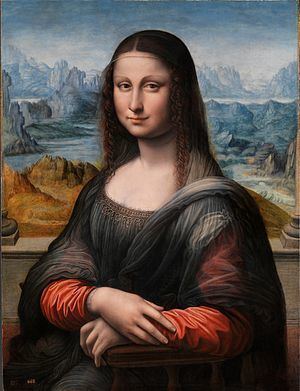Year c. 1503–16 Medium Juglans regia | Type Oil | |
 | ||
Artist Workshop of Leonardo da Vinci Subject Possibly Lisa Gherardini Dimensions 76,3 cm × 57 cm (300 in × 22 in) Similar Isleworth Mona Lisa, The Virgin and Child with St A, La belle ferronnière, St John the Baptist, Madonna of the Yarnwinder | ||
Mona lisa copy on show at spain s prado
The copy of the Mona Lisa is a painting of the same subject as Leonardo da Vinci's famous Mona Lisa (which is held by the Louvre Museum, Paris). The copy painting has been displayed in the Museo del Prado in Madrid (Spain) since 1819, but was considered for decades a worthless copy. However, after its restoration in 2012, the Prado's Mona Lisa was claimed to be the earliest replica of Leonardo's masterpiece.
Contents
- Mona lisa copy on show at spain s prado
- Jenness cortez re imagines the mona lisa
- Background
- Rediscovery of its current appearance
- Attribution
- References
Although there are dozens of surviving replicas of Mona Lisa from the 16th and 17th centuries, the Prado's Mona Lisa is said to be, scientifically, the version with the most historical value. Furthermore, the replica was discovered to be possibly painted simultaneously by a student of Leonardo in the same studio where da Vinci painted his own Mona Lisa. Among the pupils of Leonardo, Salaì or Francesco Melzi are the most plausible authors of the Prado's version, though other experts opine that the painting could have been executed by one of Leonardo's Spanish students.
Jenness cortez re imagines the mona lisa
Background
The origins of the Prado's Mona Lisa are linked to those of Leonardo's original, as both paintings were likely created simultaneously in the same studio. The first documentary reference was made in the 1666 inventory in the Galleria del Mediodia of the Alcazar in Madrid as Mujer de mano de Leonardo Abince (Leonardo da Vinci’s handy woman). However, it still unknown when the portrait entered the Spanish Royal Collection, though it could have been already in Spain in the early years of the 17th century. Since the Prado's founding in 1819, the replica has been part of its permanent collection, habitually displayed in the museum.
Rediscovery of its current appearance
Previous to its restoration, the painting was catalogued as an anonymous copy from the first quarter of the 16th century. However, it usually hung in the Prado alongside masterpieces of Italian artists such as Raphael or Andrea del Sarto; a lithography of the painting also exists, which is unusual for an anonymous copy.
Although there were elements that clearly distinguished the replica from the Louvre's version, the most striking point was the fact that until the restoration of the Prado's version, no landscape background was visible. That landscape was fully recovered through the restoration carried out by the Prado between 2010 and 2012, for a request to include the Prado's work in a temporary exhibition in the Louvre called Leonardo's last masterpiece: The Sainte Anne, from 29 March to 25 June 2012. The oxidized varnishes indicated that the black repaint had been made 200 years after the copy was painted, that is to say, not before 1750. During this restoration process, the copy was also submitted to a study of infrared reflectography and radiography, where the results revealed that the painting had been made in the workshop of Leonardo da Vinci at the same time as the original Mona Lisa was painted. The "key" of this discovery was the underlying drawing, as it is the same but with different style in both paintings, as well as the drawing's corrections.
These findings, coupled with the excellent state of preservation in regard to the Louvre's version, show the original colours of the Prado's painting and indicates what the copy must have originally looked like, as the varnish on the original has become cracked and yellowed with age. It is anticipated that such revelations also may offer further insight into Leonardo's original.
Attribution
Before the restoration and due to its repaint, the Prado's copy sometimes was attributed to a Flemish painter. This came about because it was long assumed that the copy's wooden frame was oak. However, during the 2010 restoration, researchers realized the frame's material is walnut, an expensive wood frequently used in works of Leonardo, such as Lady with an Ermine, La belle ferronnière or Saint John the Baptist.
After the restoration, it was suggested that two of Leonardo's pupils, Francesco Melzi or Salaì, were among the probable painters, though others questioned this assumption; they suggest the author could have been a Spanish student of Leonardo, namely Fernando Yáñez de la Almedina or Hernando de los Llanos. The painting cannot be considered as a typical workshop copy due to its careful and thorough execution, as well as its use of materials such as lapis lazuli or red lacquer.
